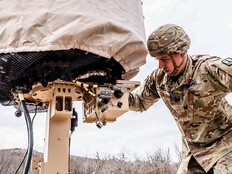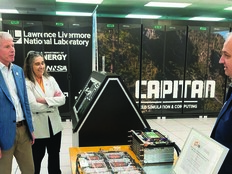FEDTECH: Are you seeing a big demand or a big response from people who are using artificial intelligence with Teams? You mentioned a popular AI use case in government with meeting transcripts. People love that. Are there other uses that might improve the meeting experience?
PAYNE: AI coming to meetings is revolutionary for the types of capabilities it brings. If you take AI out of the equation, and you miss a meeting, you miss the meeting. You can’t participate, and you’re left out at that point. The best case is to hope that someone took some notes, and then you can review those notes. The second-best case is that someone recorded the meeting and now you have to reinvest that same amount of time. So, you’re behind no matter what. And, of course, we are all overbooked.
When you are in a meeting, AI can really make a difference. It starts with being able to follow along with all of the speakers in the meeting. Already, you’re able to get a couple of really good outputs. I can tell you who participated in the meeting, how much they spoke, and I can do that relative to their audience. I can follow all of that transcription. I can join a meeting late and ask it to catch me up.
Let’s say it’s an hourlong meeting, and I’m 30 minutes late. What did I miss in the first 30 minutes? AI can tell me who was talking the most and related things. It’s a great way to encourage participation in meetings. Copilot unlocks some tremendous capabilities. It’s following the meeting and listening to produce a transcript. Copilot can explain concepts to me, and it can do this asynchronously without interrupting the speaker.
Copilot can assist you with asking interesting or introspective questions. If you were presenting to me on a given topic, I might ask Copilot what you didn’t address. It can serve as a smart question prompter. That’s a great capability.
And consider meeting hygiene. There’s no reason to come to a meeting unless people are going to make a decision or create action items and follow-ups. The system can do that and then review it quickly at the end of the meeting to make sure that it’s accurate there was consensus. The meetings themselves actually become more productive, and meetings are not inherently burdens to busy participants.
Teams also can give you important reminders if you’ve got five minutes or 10 minutes left in your meeting, for example. The first thing I do is ask Copilot to help me wrap up and summarize the action items and the agreements. Everybody can look at those things before we close out, and then meetings are more effective.
RELATED: Microsoft Copilot is flying to agencies.
FEDTECH: We produce a lot of product reviews as a service to our readers. And we see a lot of vendors, such as HP & Poly and Logitech, that are working to extend the capability of Teams or to contour the Teams experience. Do you work with these vendors in some sort of way? Do you work together with those vendors or with managed service providers to improve the meeting experience for federal agencies?
PAYNE: The Teams interface itself is great for collaboration, but we know it’s not everything for collaboration. There are things you may want to do if you’re a federal agency gathering people in a conference room to include those who are working remotely. With Teams, when you first join a meeting, it prompts me, “How do you want to join that meeting?” Do I join right now because I’m in the conference room? Does it ask me to join because it’s looking at my calendar, and it knows that I’m booked for that meeting on my calendar? And so, there’s a tight integration with a lot of tools and platforms that make the experience seamless.
Inevitably, everyone struggles for the first few minutes of a meeting to confirm that they are being seen and heard. Can you hear me? Can you see me? We’ve taken a lot of that out of the game. It’s only a simple click to join. The system is able to interact with those partner solutions and confirm that it’s operating as you would expect it to do.
I really love this — integrating those tools allow those partner solutions to truly focus on what they do best. And then we integrate that with the meeting experience. I might be remote at a meeting, and I’m looking at a long conference table of people. Then, whenever someone is speaking, you have to peer at a small head moving or talking in the corner. But now, integrating with a camera system and a microphone system that understands voices can identify the speaker. That may tie into an AI solution that pans and zooms the camera. I can set my preferences to focus or fix what I see based on speakers or my areas of interest. It just allows me to be more present in that meeting. Presence is why I’m there, and I want to get value out of it.
DISCOVER: Government is in the “second phase of interoperability.
FEDTECH: With regard to digital workspace and digital meetings, what future developments do you foresee?
PAYNE: I have two answers here. First, we continue to invest in the platform and certainly hear the customer demand for features. You’re probably aware that we have different compliance environments that the government uses based on individual regulatory guidance, whether that’s in commercial environments, the government community cloud and others, but we continue to bring the commercial innovation that you see there first into all those environments based on the customer demand. We continue to iterate there and meet our customers where they are from a compliance point of view.
But if I were to look into my crystal ball, I think we will see developments in terms of externally facing applications and usages of Teams. As people become more comfortable with this type of communication platform being used internally at agencies, we can frame that then in the context of external citizen service delivery. How can we be more accessible? How can we be more inclusive?
If someone has questions about a government program, imagine being able to use a bot on the website to answer a couple of questions. And the next logical step is to help me talk to an expert, so then a field service worker or a knowledge worker that works for that agency picks up the line. The Teams interface works great through a browser. Maybe we’re translating across languages if English isn’t my first language. Maybe I’m using the inclusive capabilities around the live captions to follow along. We can actually deliver citizen services in an externally facing way in a more efficient way.












